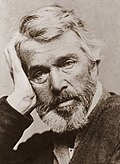Main Page
From today's featured article
Archaeology, Anthropology, and Interstellar Communication is a collection of essays about the search for extraterrestrial intelligence (SETI), edited by Douglas Vakoch and published by NASA in 2014. Each of its four sections explores a different topic: (1) the history of SETI as a field; (2) archaeological comparisons for human–alien communication, such as the difficulties of translating ancient languages; (3) the inferential gap between humans and aliens, and the consequences this would have for communication and trade; and (4) the potential nature of alien intelligences. Upon its release, the book received widespread media coverage and generally positive reviews. It was at the center of controversy when publications such as TheBlaze, The Huffington Post, and Artnet misreported a quote about ancient stone carvings from one of its essays, which rhetorically stated that the carvings "might have been made by aliens" for all that they were understood by modern anthropologists. (Full article...)
Did you know ...
- ... that Thomas Carlyle (pictured) was the first writer to use the expression "meaning of life"?
- ... that T Express is the tallest, tenth-fastest and third-longest wooden roller coaster in the world?
- ... that John Bunker was inspired to propagate old apple tree varieties after encountering Black Oxford apples while managing the food co-op in Belfast, Maine?
- ... that The Science of Dune contains a scientific analysis of the fictional concepts from the Dune franchise, such as sandworms, stillsuits, and the fictional drug melange?
- ... that the NCAA suspended all Yale University athletes for two years after basketball player Jack Langer played in the 1969 Maccabiah Games?
- ... that The Wicked Prince by Hans Christian Andersen, published in 1840, depicts powered and steerable flight twelve years before the first successful airship flight?
- ... that on 9 August 1673 a Dutch naval squadron reconquered New York from the English?
- ... that South Carolina Gamecocks head coach Will Muschamp told Jalin Hyatt: "Man, you're fast, but you need to eat more peanut butter"?
In the news
- The Hazara Express train derails in Sindh, Pakistan, killing 30 people.
- In cricket, the Ashes concludes with Australia retaining the trophy, drawing the series against England (Compton–Miller Medal recipient Chris Woakes pictured).
- In cycling, Demi Vollering wins the Tour de France Femmes.
- IS–KP kill more than 60 people in a suicide bombing at a political rally in Khar, Pakistan.
On this day
August 10: Torch Festival in China (2023)
- 1270 – Yekuno Amlak deposed the last Zagwe king and seized the imperial throne of Ethiopia, beginning the reign of the Solomonic dynasty, which would last for more than 700 years.
- 1793 – The Louvre (pyramid pictured) in Paris, today the world's most-visited museum, opened with an exhibition of 537 paintings and 184 objets d'art.
- 1953 – First Indochina War: The French Union withdrew its forces from Operation Camargue against the Việt Minh in central modern-day Vietnam.
- 1988 – The Civil Liberties Act of 1988 became law, authorizing reparations to surviving Japanese Americans interned during World War II.
- 2019 – Jeffrey Epstein, an American financier and convicted sex offender, was found dead in his cell at the Metropolitan Correctional Center, New York.
- Therese Forster (b. 1786)
- Eric Harrison (b. 1886)
- Aletta Jacobs (d. 1929)
- Casey Donovan (d. 1987)
Today's featured picture

|
The Young Sabot Maker is an oil-on-canvas painting made by the American artist Henry Ossawa Tanner in 1895. It was accepted for the 1895 Paris Salon, and was Tanner's second painting entered for the Salon. The painting follows a theme Tanner used for his genre paintings, "age instructing youth", which can also be seen in The Bagpipe Lesson and The Banjo Lesson. It depicts an older man proudly watching a boy push with his weight against the crossbar handle of a sawhorse to carve a sabot, or wooden shoe. The two figures stand within the sabot maker's workshop, with wood shavings scattered around them on the floor. The painting was purchased by a group of donors and sponsors and given to the Nelson-Atkins Museum of Art in Kansas City, Missouri, in 1995. Painting credit: Henry Ossawa Tanner
Recently featured:
|
Other areas of Wikipedia
- Community portal – The central hub for editors, with resources, links, tasks, and announcements.
- Village pump – Forum for discussions about Wikipedia itself, including policies and technical issues.
- Site news – Sources of news about Wikipedia and the broader Wikimedia movement.
- Teahouse – Ask basic questions about using or editing Wikipedia.
- Help desk – Ask questions about using or editing Wikipedia.
- Reference desk – Ask research questions about encyclopedic topics.
- Content portals – A unique way to navigate the encyclopedia.
Wikipedia's sister projects
Wikipedia is written by volunteer editors and hosted by the Wikimedia Foundation, a non-profit organization that also hosts a range of other volunteer projects:
-
Commons
Free media repository -
MediaWiki
Wiki software development -
Meta-Wiki
Wikimedia project coordination -
Wikibooks
Free textbooks and manuals -
Wikidata
Free knowledge base -
Wikinews
Free-content news -
Wikiquote
Collection of quotations -
Wikisource
Free-content library -
Wikispecies
Directory of species -
Wikiversity
Free learning tools -
Wikivoyage
Free travel guide -
Wiktionary
Dictionary and thesaurus
Wikipedia languages
This Wikipedia is written in English. Many other Wikipedias are available; some of the largest are listed below.
-
1,000,000+ articles
-
250,000+ articles
-
50,000+ articles




